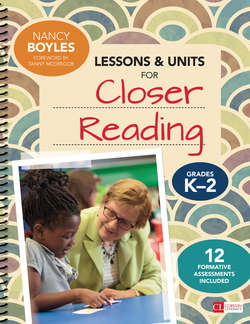Читать книгу Lessons and Units for Closer Reading, Grades K-2 - Nancy Boyles - Страница 20
На сайте Литреса книга снята с продажи.
4. Assess close reading appropriately with formative assessments.
ОглавлениеAssessing comprehension in the primary grades is a dilemma. Summative assessment (such as high-stakes state tests) don’t work well. Children change so quickly in the primary grades that those scores become quickly outdated. Formative assessments make sense because they examine students’ day-to-day performance and guide our next instructional steps. However, even using these can get complicated. For example, asking students to do an oral retell is not really an authentic reader task. (How often do you retell a book blow-by-blow?) And to make it worse, for some published assessments, the criteria for success deliver data that are questionable in their alignment to new standards. On the other hand, we don’t want to thrust a pencil in students’ hands too soon and expect them to write extensively about their reading. Trust me, the outcome here is not great answers, but a lot of crying kids!
Courtesy of Rick Harrington Photography
So what’s the solution? As a first-grade teacher of many years, I heartily endorse classroom discussion as a window into students’ comprehension. Ask yourself: Who willingly responds when you pose questions? Are the responses accurate? Are they insightful? Can students elaborate on an answer with details from the text? Do they readily connect texts? These simple indicators are perhaps our best way to gauge students’ developing comprehension competencies.
